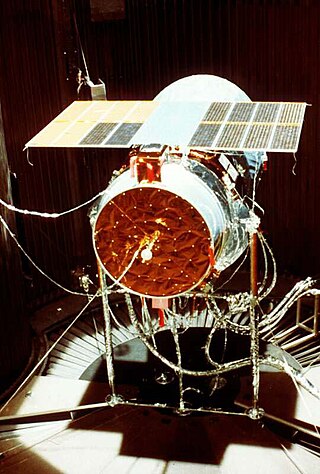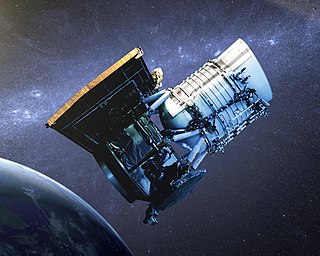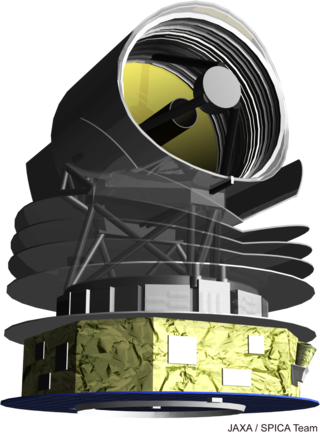Infrared astronomy is a sub-discipline of astronomy which specializes in the observation and analysis of astronomical objects using infrared (IR) radiation. The wavelength of infrared light ranges from 0.75 to 300 micrometers, and falls in between visible radiation, which ranges from 380 to 750 nanometers, and submillimeter waves.

Subaru Telescope is the 8.2-metre (320 in) telescope of the National Astronomical Observatory of Japan, located at the Mauna Kea Observatory on Hawaii. It is named after the open star cluster known in English as the Pleiades. It had the largest monolithic primary mirror in the world from its commissioning until the Large Binocular Telescope opened in 2005.

The Infrared Astronomical Satellite (IRAS) was the first space telescope to perform a survey of the entire night sky at infrared wavelengths. Launched on 25 January 1983, its mission lasted ten months. The telescope was a joint project of the United States (NASA), the Netherlands (NIVR), and the United Kingdom (SERC). Over 250,000 infrared sources were observed at 12, 25, 60, and 100 micrometer wavelengths.

The Spitzer Space Telescope, formerly the Space Infrared Telescope Facility (SIRTF), is an infrared space telescope launched in 2003, that was deactivated when operations ended on 30 January 2020. Spitzer was the third space telescope dedicated to infrared astronomy, following IRAS (1983) and ISO (1995–1998). It was the first spacecraft to use an Earth-trailing orbit, later used by the Kepler planet-finder.

The Infrared Space Observatory (ISO) was a space telescope for infrared light designed and operated by the European Space Agency (ESA), in cooperation with ISAS and NASA. The ISO was designed to study infrared light at wavelengths of 2.5 to 240 micrometres and operated from 1995 to 1998.

The Japan Aerospace Exploration Agency (JAXA) is the Japanese national air and space agency. Through the merger of three previously independent organizations, JAXA was formed on 1 October 2003. JAXA is responsible for research, technology development and launch of satellites into orbit, and is involved in many more advanced missions such as asteroid exploration and possible human exploration of the Moon. Its motto is One JAXA and its corporate slogan is Explore to Realize.

NASA's series of Great Observatories satellites are four large, powerful space-based astronomical telescopes launched between 1990 and 2003. They were built with different technology to examine specific wavelength/energy regions of the electromagnetic spectrum: gamma rays, X-rays, visible and ultraviolet light, and infrared light.

The Herschel Space Observatory was a space observatory built and operated by the European Space Agency (ESA). It was active from 2009 to 2013, and was the largest infrared telescope ever launched until the launch of the James Webb Space Telescope in 2021. Herschel carries a 3.5-metre (11.5 ft) mirror and instruments sensitive to the far infrared and submillimetre wavebands (55–672 μm). Herschel was the fourth and final cornerstone mission in the Horizon 2000 programme, following SOHO/Cluster II, XMM-Newton and Rosetta.

The European Space Astronomy Centre (ESAC) near Madrid in Spain is the ESA's centre for space science. It hosts the science operation centres for all ESA astronomy and planetary missions together with their scientific archives. Past and present missions represented at ESAC include Akari, BepiColombo, Cassini–Huygens, Cluster, Exomars, Gaia, Herschel Space Observatory, Hubble Space Telescope, ISO, INTEGRAL, IUE, James Webb Space Telescope, LISA Pathfinder, Mars Express, Planck, Rosetta, SOHO, Solar Orbiter, Venus Express, and XMM-Newton.

Suzaku was an X-ray astronomy satellite developed jointly by the Institute of Space and Aeronautical Science at JAXA and NASA's Goddard Space Flight Center to probe high-energy X-ray sources, such as supernova explosions, black holes and galactic clusters. It was launched on 10 July 2005 aboard the M-V launch vehicle on the M-V-6 mission. After its successful launch, the satellite was renamed Suzaku after the mythical Vermilion bird of the South.

Wide-field Infrared Survey Explorer is a NASA infrared astronomy space telescope in the Explorers Program launched in December 2009. WISE discovered thousands of minor planets and numerous star clusters. Its observations also supported the discovery of the first Y-type brown dwarf and Earth trojan asteroid. WISE performed an all-sky astronomical survey with images in 3.4, 4.6, 12 and 22 μm wavelength range bands, over ten months using a 40 cm (16 in) diameter infrared telescope in Earth orbit.
Frank James Low was a solid state physicist who became a leader in the new field of infrared astronomy, after inventing the gallium doped germanium bolometer in 1961. This detector extended the range of the observable spectrum to much longer wavelengths.
1749 Telamon is a dark Jupiter Trojan from the Greek camp, approximately 70 kilometers in diameter. It was discovered by German astronomer Karl Reinmuth at the Heidelberg Observatory on 23 September 1949, and named after Telamon from Greek mythology. The D-type asteroid is the principal body of the proposed Telamon family and belongs to the 60 largest Jupiter trojans. It has a rotation period of 17.0 hours and possibly a spherical shape.
2629 Rudra, provisional designation 1980 RB1, is a sizable Mars-crossing asteroid and slow rotator inside the asteroid belt, approximately 5.3 kilometers (3.3 miles) in diameter. It was discovered on 13 September 1980, by American astronomer Charles Kowal at the Palomar Observatory in California. The dark B-type asteroid has a long rotation period 123 hours and likely an elongated shape. It was named after Rudra from Hindu mythology.

Hitomi, also known as ASTRO-H and New X-ray Telescope (NeXT), was an X-ray astronomy satellite commissioned by the Japan Aerospace Exploration Agency (JAXA) for studying extremely energetic processes in the Universe. The space observatory was designed to extend the research conducted by the Advanced Satellite for Cosmology and Astrophysics (ASCA) by investigating the hard X-ray band above 10 keV. The satellite was originally called New X-ray Telescope; at the time of launch it was called ASTRO-H. After it was placed in orbit and its solar panels deployed, it was renamed Hitomi. The spacecraft was launched on 17 February 2016 and contact was lost on 26 March 2016, due to multiple incidents with the attitude control system leading to an uncontrolled spin rate and breakup of structurally weak elements.

The Space Infrared Telescope for Cosmology and Astrophysics (SPICA), was a proposed infrared space telescope, follow-on to the successful Akari space observatory. It was a collaboration between European and Japanese scientists, which was selected in May 2018 by the European Space Agency (ESA) as a finalist for the next Medium class Mission 5 (M5) of the Cosmic Vision programme, to launch in 2032. At the time the other two finalists were THESEUS and EnVision, with the latter that was eventually selected for further development. SPICA would have improved on the spectral line sensitivity of previous missions, the Spitzer and Herschel space telescopes, between 30 and 230 µm by a factor of 50—100.
39 Leonis is the Flamsteed designation for a star in the zodiac constellation of Leo. It has an apparent visual magnitude of 5.90, so, according to the Bortle scale, it is faintly visible from suburban skies at night. Parallax measurements show an annual parallax shift of 0.0449″, which is equivalent to a distance of around 72.6 ly (22.3 pc) from the Sun.
Orbiting Binary Black Hole Investigation Satellite (ORBIS) is a small space telescope still in development by Japan that will study binary black holes in the X-ray region.
LiteBIRD is a planned small space observatory that aims to detect the footprint of the primordial gravitational wave on the cosmic microwave background (CMB) in a form of polarization pattern called B-mode.












